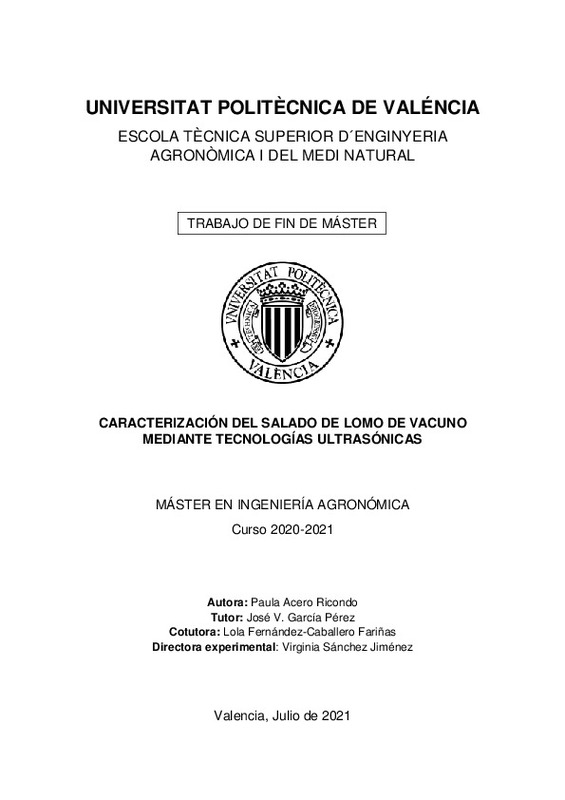|
Resumen:
|
[EN] In recent years, the agri-food sector has shown growing interest in the development of
methods and technologies capable of controlling and monitoring in a non-invasive way and
in real time quality parameters at the ...[+]
[EN] In recent years, the agri-food sector has shown growing interest in the development of
methods and technologies capable of controlling and monitoring in a non-invasive way and
in real time quality parameters at the level of the production line, this being an aspect closely
linked to movement of Industry 4.0. In this context, ultrasonic technologies represent a lowcost alternative for the characterization of food in production lines. Specifically, conventional
contact ultrasonic technologies have been used successfully to characterize both the
composition and the textural properties of different meat products, such as sobrasada and
cured ham. However, its use at an industrial level has been hampered by the need for contact
between the sample and the transducers. On the contrary, the use of new ultrasonic
technologies with air coupling allow the measurement to be carried out without contact,
facilitating its industrial implementation. Thus, the general objective of the present work was
to determine the feasibility of using non-contact ultrasound for the characterization of texture
and compositional changes during the salting of beef loin fillets, comparing it with contact
ultrasonic technologies.
To achieve the objective of this work, contact (1 MHz) and non-contact (380 kHz) ultrasonic
measurements have been performed on previously thawed beef fillets. The samples have
been subjected to different dry salting times from 1 to 24 h. Ultrasonic parameters of interest
were determined such as the ultrasonic speed, from the variation of the flight time, and the
maximum amplitude of the signal for both contact and non-contact measurements. The
salting process was characterized by the evolution of different physical-chemical parameters
such as chloride content, humidity, activity and water retention capacity and different textural
parameters, such as hardness and relaxation capacity. Finally, relationships were
established between the ultrasonic parameters and the changes in the content of salt,
moisture and textural parameters.
The experimental results have shown that the ultrasonic parameters obtained from both
techniques used have shown to be sensitive to the salting process of beef fillets and the
associated compositional and textural changes. In this way, the speed obtained with contact
ultrasound was satisfactorily related to the salt content (R2 = 0,898), humidity (R2 = 0,903)
and hardness (R2 = 0,813) from linear models. The ratio of variation in flight time obtained
with non-contact ultrasound between salty and fresh samples was related to salt and
moisture content (R2 = 0,697), relaxation capacity (R2 = 0,788) and hardness (R2 = 0,936).
In addition, the amplitude ratio for the signals of salty and fresh samples obtained with noncontact ultrasound showed a satisfactory relationship with the moisture content (R2 = 0,773)
and salt (R2 = 0,805). Finally, it can be concluded that non-contact ultrasonics can be
considered as a technique with enormous potential to be applied in production lines and
characterize the salt content of raw-cured meat products and their texture
[-]
[ES] En los últimos años, el sector agroalimentario ha apostado por el movimiento tecnológico de la industria 4.0 con el desarrollo de métodos y tecnologías capaces de controlar y monitorizar parámetros de calidad a nivel ...[+]
[ES] En los últimos años, el sector agroalimentario ha apostado por el movimiento tecnológico de la industria 4.0 con el desarrollo de métodos y tecnologías capaces de controlar y monitorizar parámetros de calidad a nivel de línea de producción. Las tecnologías ultrasónicas representan una alternativa de bajo coste para la caracterización de alimentos en las líneas de producción. En concreto, las tecnologías ultrasónicas convencionales por contacto se han utilizado con éxito para la caracterización de tanto la composición como las propiedades texturales de diferentes productos cárnicos, como son la sobrasada y el jamón curado. Sin embargo, su uso a nivel industrial se ha visto dificultado por la necesidad del contacto entre la muestra y los transductores. Por el contrario, el uso de nuevas tecnologías ultrasónicas con acoplamiento por aire permiten realizar la medida sin contacto facilitando su implementación industrial.
El objetivo del presente trabajo pretende determinar la viabilidad del uso de los ultrasonidos sin contacto para la caracterización de textura y cambios composicionales durante el salado de filetes de lomo de vacuno comparándolo con las tecnologías ultrasónicas por contacto.
Para alcanzar el objetivo de este trabajo, se van a realizar medidas ultrasónicas con y sin contacto en lomos de ternera previamente descongelados. Las muestras se someterán a diferentes tiempos de salado en seco desde 1 a 24 horas. Las señales ultrasónicas se analizarán tanto en el dominio temporal como en el de frecuencia para determinar diferentes parámetros, tales como la velocidad y la atenuación ultrasónica. El proceso de salado se caracterizará mediante la evolución de diferentes parámetros físico-químicos como son el contenido de cloruros, actividad de agua (aw), contenido de humedad o capacidad de retención de agua. Finalmente, se establecerán relaciones entre los parámetros ultrasónicos y los cambios en los contenidos de sal, humedad y los parámetros texturales.
[-]
|







